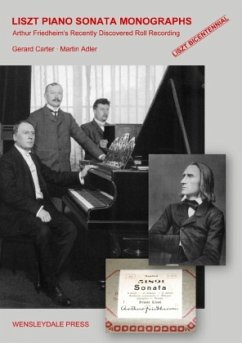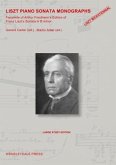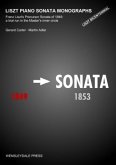Franz Liszt completed his Piano Sonata in B Minor at Weimar in 1853. It met with a mixed reception from the musical establishment of the day but is now a part of the repertoire of every leading pianist and may even be the most frequently recorded and performed piano work ever written. It is the outstanding example of the compositional process of thematic transformation. The grandeur and lyrical power of its themes, based on three motifs so clearly stated at the outset, place it at the pinnacle of the piano literature.
Wensleydale Press has launched a series of Liszt Piano Sonata Monographs on special aspects of musicological interest. Each monograph upholds the best traditions of modern musicological scholarship while presenting the contents in an attractive way for the general reader.
The first monograph, published in the (northern) autumn of 2010, discusses in detail the Hupfeld piano roll recording of the Sonata performed by Arthur Friedheim. For many years the roll was believed to have been lost or destroyed but in March 2010 it turned up in a private collection in New York. Arthur Friedheim studied the Sonata with Franz Liszt who said of his concert performance, 'that is how I thought the composition when I wrote it!' The only other recording of the Sonata by a Liszt pupil that has come down to us is that of Eugen d'Albert but he seems never to have actually studied it with Liszt himself. (Liszt pupil Josef Weiss recorded the Sonata but enquiries to-date have failed to reveal any trace of the roll.) It follows that the Friedheim roll is an epoch-making find for scholars and performers.
The first monograph discusses:
Friedheim's performances
Friedheim's piano roll
Melody-delaying and arpeggiata
Friedheim amalgam
Other harmonic changes
Other textual changes
Final bar
Tempos and metronome markings
Stylistic freedom Pedalling
Dynamics
Recitatives
Phonola range analysis
Musical aesthetic
Traditions
Timeline of performances, editions, books, recordings and events
Excerpts from Hupfeld catalogues
Tempo comparison (Friedheim vs. Brendel, Stradal and d'Albert)
Timing comparison (Friedheim vs. Brendel)
Contact: info@lisztsonata.com
More information: www.lisztsonata.com
Wensleydale Press has launched a series of Liszt Piano Sonata Monographs on special aspects of musicological interest. Each monograph upholds the best traditions of modern musicological scholarship while presenting the contents in an attractive way for the general reader.
The first monograph, published in the (northern) autumn of 2010, discusses in detail the Hupfeld piano roll recording of the Sonata performed by Arthur Friedheim. For many years the roll was believed to have been lost or destroyed but in March 2010 it turned up in a private collection in New York. Arthur Friedheim studied the Sonata with Franz Liszt who said of his concert performance, 'that is how I thought the composition when I wrote it!' The only other recording of the Sonata by a Liszt pupil that has come down to us is that of Eugen d'Albert but he seems never to have actually studied it with Liszt himself. (Liszt pupil Josef Weiss recorded the Sonata but enquiries to-date have failed to reveal any trace of the roll.) It follows that the Friedheim roll is an epoch-making find for scholars and performers.
The first monograph discusses:
Friedheim's performances
Friedheim's piano roll
Melody-delaying and arpeggiata
Friedheim amalgam
Other harmonic changes
Other textual changes
Final bar
Tempos and metronome markings
Stylistic freedom Pedalling
Dynamics
Recitatives
Phonola range analysis
Musical aesthetic
Traditions
Timeline of performances, editions, books, recordings and events
Excerpts from Hupfeld catalogues
Tempo comparison (Friedheim vs. Brendel, Stradal and d'Albert)
Timing comparison (Friedheim vs. Brendel)
Contact: info@lisztsonata.com
More information: www.lisztsonata.com








